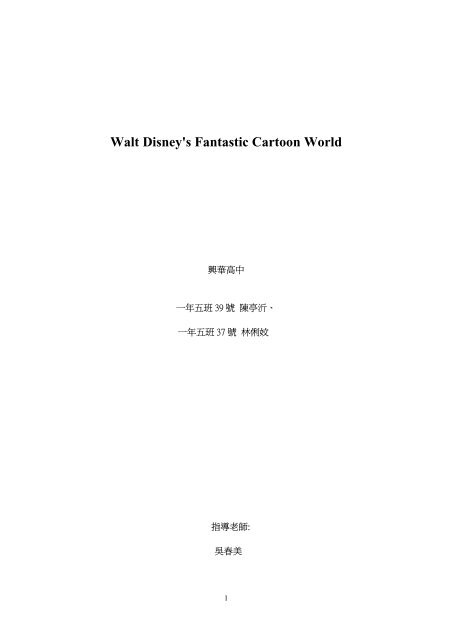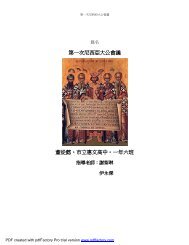Create successful ePaper yourself
Turn your PDF publications into a flip-book with our unique Google optimized e-Paper software.
<strong>Walt</strong> <strong>Disney's</strong> <strong>Fantastic</strong> <strong>Cartoon</strong> <strong>World</strong><br />
興華高中<br />
一年五班 39 號 陳亭沂、<br />
一年五班 37 號 林俐妏<br />
指導老師:<br />
吳春美<br />
1
I. Introduction<br />
<strong>Walt</strong> <strong>Disney's</strong> <strong>Fantastic</strong> <strong>Cartoon</strong> <strong>World</strong><br />
Few years, animated films have been more and more prevailing in our mind.<br />
However, it just like the earth is turning around. <strong>Cartoon</strong>s also accompany by children and<br />
make their childhood full with joy and happiness. <strong>Walt</strong> Disney created most of the cartoon<br />
characters cautiously. No matter what happened his childhood, he was capable of<br />
observing very carefully .Though his life was not smoother, he never gave up. Instead he<br />
found another way to make his dream come true. Finally, he created his cartoon world with<br />
his best friend Ubbe and his brother Roy. And we integrate these honors into the report so<br />
that everyone can be aware of more about <strong>Walt</strong> Disney and his cartoon world.<br />
II. THESIS<br />
1. Background<br />
1.1. Childhood<br />
<strong>Walt</strong> Disney was born on December 5 th in 1901.His parents are Elias Disney an<br />
Irish-Canadian.And <strong>Walt</strong> <strong>Disney's</strong> ancestors had emigrated from Gowran, County<br />
Kilkenny in Ireland.<br />
In 1906, when <strong>Walt</strong> was four, Elias and his family moved to a farm in Marceline,<br />
Missouri, where his brother Roy had recently purchased farmland. While in Marceline,<br />
<strong>Walt</strong> developed his love for drawing. One of their neighbors, a retired doctor named Doc<br />
Sherwood, paid him to draw pictures of Sherwood's horse, Rupert. He also developed his<br />
love for trains in Marceline, which owed its existence to the Atchison, Topeka and Santa<br />
Fe Railway which ran through town. <strong>Walt</strong> would put his ear to the tracks in anticipation of<br />
2
<strong>Walt</strong> <strong>Disney's</strong> <strong>Fantastic</strong> <strong>Cartoon</strong> <strong>World</strong><br />
the coming train. Then he would look for his uncle engineer Michael Martin, running the<br />
train.<br />
The Disneys remained in Marceline for four years, before moving to Kansas City in<br />
1911. After they moved there, <strong>Walt</strong> and his sister Ruth attended the Benton Grammar<br />
School where he met <strong>Walt</strong>er Pfeiffer. The Pfeiffers were theatre aficionados, and<br />
introduced <strong>Walt</strong> to the world of vaudeville and motion pictures. Soon, <strong>Walt</strong> was spending<br />
more time at the Pfeiffers' than at home.<br />
1.2. Teenage years<br />
In 1917, Elias acquired share in the O-Zell jelly factory in Chicago and moved his<br />
family back there. In the fall, Disney began his freshman year at McKinley High School<br />
and began taking night courses at the Chicago Art Institute. Disney became the cartoonist<br />
for the school newspaper. His cartoons were very patriotic, focusing on <strong>World</strong> War I.<br />
Disney dropped out of high school at the age of sixteen to join the Army, but the army<br />
rejected him because he was underage.<br />
After his rejection from the army, <strong>Walt</strong> and one of his friends decided to join the Red<br />
Cross. Soon, after he joined the Red Cross, <strong>Walt</strong> was sent to France for a year, where he<br />
drove an ambulance.<br />
In 1919, <strong>Walt</strong> hoped to find work outside the Chicago Ozell factory, left home and<br />
moved back to Kansas City to begin his artistic career. He considered whether become an<br />
actor or a newspaper artist. And then he decided he wanted to create a career in the<br />
3
<strong>Walt</strong> <strong>Disney's</strong> <strong>Fantastic</strong> <strong>Cartoon</strong> <strong>World</strong><br />
newspaper, drawing political charicatures or comic strips. When nobody wanted to hire<br />
him either likes an artist or likes an ambulance driver. His brother Roy, who worked at a<br />
bank in the area, got a temporarily job for him at the Pesmen-Rubin Art Studio through a<br />
bank colleague. At Pesmen-Rubin, Disney created ads for newspapers, magazines and<br />
movie theaters. It was here that he met a cartoonist named Ubbe Iwerks. When their time<br />
at the Pesmen-Rubin Art Studio expired and both of them weren't having any job. So they<br />
decided to establish their own commercial company.<br />
In January 1920, <strong>Walt</strong> and Iwerks formed a short-lived company called,<br />
"Iwerks-Disney Commercial Artists". However, following a rough start, <strong>Walt</strong> left<br />
temporarily to earn money at Kansas City Film Ad Company, and was soon joined by<br />
Iwerks who was not able to run the business alone. While working for the Kansas City<br />
Film Ad Company, where he made commercials based on cutout animation, <strong>Walt</strong> took up<br />
an interest in the field of animation and decided to become an animator. He was allowed<br />
by the owner of the Ad Company, A.V. Cauger to borrow a camera from work, which he<br />
could use to experiment with at home. After reading a book by Edwin G. Lutz, called<br />
Animated <strong>Cartoon</strong>s: How They Are Made, Their Origin and Development, and he found<br />
cel animation to be much more promising than the cutout animation he was doing for<br />
Cauger. <strong>Walt</strong> eventually decided to open his own animation business, and recruited a<br />
fellow co-worker at the Kansas City Film Ad Company, Fred Harman as his first<br />
employee.<br />
1.3. Laugh O'Gram Studio<br />
4
<strong>Walt</strong> <strong>Disney's</strong> <strong>Fantastic</strong> <strong>Cartoon</strong> <strong>World</strong><br />
Presented as "Newman Laugh-O Grams," <strong>Walt</strong>'s cartoons became widely popular in the<br />
Kansas City area. Through the success of Laugh-O Grams, <strong>Walt</strong> was able to acquire his<br />
own studio and hire a vast number of additional animators, including Fred Harman's<br />
brother Hugh Harman, Rudolph Isling, and his close friend Ubbe Iwerks. Unfortunately,<br />
with all his high employee salaries unable to make up for studio profits, <strong>Walt</strong> was unable<br />
to successfully manage money and as a result, and the studio would become loaded with<br />
debt. The studio would eventually wind up bankrupt, <strong>Walt</strong> then set his sights on<br />
establishing a studio in the movie industry's capital city, Hollywood inCalifornia.<br />
1.4. Hollywood<br />
<strong>Walt</strong> and his brother pooled their money to set up a cartoon studio in Hollywood.<br />
Needing to find a distributor for his new Alice Comedies, which he started making while<br />
in Kansas City, but never got to distribute, <strong>Walt</strong> sent an unfinished print to New York<br />
distributor Margaret Winkler, who promptly wrote back to him. She was keen on a<br />
distribution deal with <strong>Walt</strong> for more live-action and animated shorts based upon "Alice's<br />
Wonderland".<br />
2. Achievement<br />
2.1. Oswald the Lucky Rabbit<br />
In 1927 the new series, "Oswald the Lucky Rabbit" was an almost instant success,<br />
and the character, Oswald drawn and created by Iwerks and became a popular figure. The<br />
Disney studio expanded <strong>Walt</strong> hired back Harman, Rudolph Ising, Carman Maxwell, and<br />
5
<strong>Walt</strong> <strong>Disney's</strong> <strong>Fantastic</strong> <strong>Cartoon</strong> <strong>World</strong><br />
Friz Freleng from Kansas City. In February 1928, <strong>Walt</strong> went to New York to negotiate a<br />
higher fee per short from Mintz. And <strong>Walt</strong> was shocked when Mintz announced that not<br />
only he wanted to reduce the fee he paid <strong>Walt</strong> per short but also that he had most of his<br />
main animators including Harman, Ising, Maxwell, and Freleng under contract and would<br />
start his own studio if <strong>Walt</strong> did not accept the reduced production budgets. Universal, not<br />
<strong>Walt</strong> owned the Oswald trademark, and could make the films without Disney. <strong>Walt</strong><br />
declined Mintz's offer and lost most of his animation staff.<br />
2.2. Mickey Mouse<br />
After losing the Oswald, <strong>Walt</strong> felt the need to develop a new character to replace him.<br />
He based the character on a mouse he had adopted as a pet while working in a Kansas City<br />
studio. Ub Iwerks reworked on the sketches made by <strong>Walt</strong>, so that it was easier to animate<br />
it. However, Mickey's voice and personality was provided by <strong>Walt</strong>. Many of animators<br />
have commented, "Ub designed Mickey's physical appearance, but <strong>Walt</strong> gave him his<br />
soul." Besides Oswald and Mickey, a similar mouse character is seen in "Alice Comedies"<br />
which featured a mouse named Ike the Mouse, and the first Flip the Frog cartoon called<br />
Fiddlesticks, which showed a Mickey Mouse look like playing fiddle. The initial films<br />
were animated by Iwerks, his name was prominently featured on the title cards. The mouse<br />
was originally named "Mortimer", but later christened "Mickey Mouse" by his wife Lillian<br />
Disney who thought that the name Mortimer did not fit. Mortimer later became the name<br />
of Mickey's rival for Minnie, who was taller than his renowned adversary and had a<br />
Brooklyn accent.<br />
6
<strong>Walt</strong> <strong>Disney's</strong> <strong>Fantastic</strong> <strong>Cartoon</strong> <strong>World</strong><br />
The first animated short with Mickey in it was titled, "Plane Crazy", which was like<br />
all of <strong>Walt</strong>'s previous works, a silent film. After failing to find a distributor for "Plane<br />
Crazy" or its follow-up, "The Gallopin' Gaucho", <strong>Walt</strong> created a Mickey cartoon with<br />
sound called "Steamboat Willie". A businessman named Pat Powers provided <strong>Walt</strong> with<br />
both distribution and Cinephone, a sound-synchronization process. "Steamboat Willie"<br />
became an instant success, "Plane Crazy", "The Galloping Gaucho", and all future Mickey<br />
cartoons were released with soundtracks.<strong>Walt</strong> provided the vocal effects for the earliest<br />
cartoons and performed as the voice of Mickey Mouse until 1946. After the release of<br />
"Steamboat Willie", <strong>Walt</strong> would continue to successfully use sound in all of his future<br />
cartoons, and Cinephone became the new distributor for <strong>Walt</strong>'s early sound cartoons as<br />
well. Mickey soon eclipsed Felix the Cat as the world's most popular cartoon character.In<br />
1930, Felix,<br />
now in sound, had faded from the screen, as his sound cartoons failed to gain attention.<br />
Mickey's popularity would now skyrocket in the early 1930s.<br />
2.3. Silly Symphonies<br />
Following the footsteps of Mickey Mouse series, a series of musical shorts titled,<br />
"Silly Symphonies" was released in 1929. The first of these was titled "The Skeleton<br />
Dance "and was entirely drawn and animated by Iwerks, who was also responsible for<br />
7
<strong>Walt</strong> <strong>Disney's</strong> <strong>Fantastic</strong> <strong>Cartoon</strong> <strong>World</strong><br />
drawing the majority of cartoons released by <strong>Walt</strong> in 1928 and 1929. Although both series<br />
were successful, the Disney studio was not seeing its rightful share of profits from Pat<br />
Powers. And in 1930, <strong>Walt</strong> signed a new distribution deal with Columbia Pictures. The<br />
original the basis of the cartoons were musical novelty, and Carl Stalling wrote the score<br />
for the first Silly Symphony cartoons as well.<br />
Iwerks was soon lured by Powers into opening his own studio with an exclusive<br />
contract. Later, Carl Stalling would also leave <strong>Walt</strong> to join Iwerks' new studio. Iwerks<br />
launched his Flip the Frog series with first voice cartoon in color, Fiddlesticks, filmed in<br />
two-strip Technicolor. Iwerks also created two other series of cartoons, the Willie<br />
Whopper and the Comicolor. In 1936, Iwerks shut his studio to work on various projects<br />
dealing with animation technology. He would return to <strong>Walt</strong> in 1940, he would go on to<br />
pioneer a number of film processes and specialized animation technologies in the studio's<br />
research and development department.<br />
By 1932, Mickey Mouse had become quite a popular cinema character, but Silly<br />
Symphonies was not as successful. In the same year also saw competition for <strong>Walt</strong> grow<br />
worse as Max Fleischer's flapper cartoon character, Betty Boop would gain more<br />
popularity among theater audiences. Fleischer was considered to be <strong>Walt</strong>'s main rival in the<br />
1930s, and was also the father of Richard Fleischer, whom <strong>Walt</strong> would later hire to direct<br />
his 1954 film "20,000 Leagues Under the Sea". Meanwhile, Columbia Pictures dropped the<br />
distribution of Disney cartoons and was replaced by United Artists. In late 1932, Herbert<br />
Kalmus, who had just completed work on the first three-strip technicolor camera,<br />
8
<strong>Walt</strong> <strong>Disney's</strong> <strong>Fantastic</strong> <strong>Cartoon</strong> <strong>World</strong><br />
approached <strong>Walt</strong> and convinced him to redo "Flowers and Trees", which was originally<br />
done in black and white, with three-strip Technicolor. Flowers and Trees would go on to<br />
be a phenomenal success and would also win the first Academy Award for Best Short<br />
Subject: <strong>Cartoon</strong>s for 1932. After Flowers and Trees was released, all future Silly<br />
Symphony cartoons were done in color as well. <strong>Walt</strong> was also able to negotiate a two-year<br />
deal with technicolor, giving him the sole right to use three-strip technicolor, which would<br />
also eventually be extended to five years as well. Through Silly Symphonies, <strong>Walt</strong> would<br />
also create his most successful cartoon short of all time, "The Three Little Pigs" in 1933.<br />
The cartoon ran in theaters for many months, and also featured the hit song that became the<br />
anthem of the Great Depression "Who's Afraid of the Big Bad Wolf".<br />
2.4. First Academy Award<br />
In 1932, <strong>Walt</strong> received a special Academy Award for the creation of "Mickey Mouse",<br />
whose series was made into color in 1935 and soon launched spin-off series for supporting<br />
characters such as Donald Duck, Goofy and Pluto. Pluto and Donald would immediately<br />
get their individual cartoons in 1937, and Goofy would get solo cartoons in 1939 as well.<br />
Of all of Mickey's partners, Donald Duck who first teamed with Mickey in the 1934<br />
cartoon, "Orphan's Benefit" was arguably the most popular, and went on to become <strong>Walt</strong>'s<br />
second most successful cartoon character of all time.<br />
3. Prospect and Death<br />
3.1. Of <strong>Walt</strong> Disney<br />
9
<strong>Walt</strong> <strong>Disney's</strong> <strong>Fantastic</strong> <strong>Cartoon</strong> <strong>World</strong><br />
After the creation of two cartoon series, <strong>Walt</strong> soon began plans for a full-length<br />
feature in 1934. In 1935, opinion polls showed that another cartoon series, "Popeye the<br />
Sailor", produced by Max Fleischer was more popular than Mickey Mouse. However, <strong>Walt</strong><br />
was able to put Mickey back on top, and also increase Mickey's popularity further by<br />
colorizing him and partially redesigning him into what was considered to be his most<br />
appealing design up to this point in time. When the film industry came to know about<br />
<strong>Walt</strong>'s plans to produce an animated feature-length version of "Snow White", they dubbed<br />
the project as "<strong>Disney's</strong> Folly" and were certain that the project would destroy the Disney<br />
studio. Both Lillian and Roy tried to talk <strong>Walt</strong> out of the project, but he continued plans for<br />
the feature. He employed Chouinard Art Institute professor Don Graham to start a training<br />
operation for the studio staff, and used the Silly Symphonies as a platform for experiments<br />
in realistic human animation, distinctive character animation, special effects and the use of<br />
specialized processes and apparatus such as the multiplane camera. <strong>Walt</strong> Disney would<br />
first use this new technique in the 1937 Silly Symphonies short The Old Mill.<br />
All of this development and training was used to elevate the quality of the studio so<br />
that it would be able to give the feature film the quality <strong>Walt</strong> desired. Snow White and the<br />
Seven Dwarfs as the feature was named, in full production from 1934 until mid in 1937,<br />
when the studio ran out of money. To acquire the funding to complete Snow White, <strong>Walt</strong><br />
had to show a rough cut of the motion picture to loan officers at the Bank of America, who<br />
gave the studio the money to finish the picture. The finished film premiered at the Carthay<br />
Circle Theater on December 21 in 1937 at the conclusion of the film, the audience gave<br />
10
<strong>Walt</strong> <strong>Disney's</strong> <strong>Fantastic</strong> <strong>Cartoon</strong> <strong>World</strong><br />
Snow White and the Seven Dwarfs a standing ovation. Snow White, the first<br />
animated feature in English and Technicolor was released in February 1938 under a new<br />
distribution deal with RKO Radio Pictures. RKO had previously been the distributor for<br />
Disney cartoons in 1936, after it closed down the Van Beuren Studios in exchange for<br />
distribution. The film became the most successful motion picture of 1938 and earned over<br />
$8 million in its original theatrical release.<br />
3.2. The Golden Age of Animation<br />
The success of Snow White allowed <strong>Walt</strong> to build a new campus for the <strong>Walt</strong> Disney<br />
Studios in Burbank, which opened for business on December 24 in 1939. Snow White was<br />
not only the peak of <strong>Walt</strong>'s success but it also ushered into what was known as the Golden<br />
Age of Animation for <strong>Walt</strong>. The feature animation staff, having just completed Pinocchio,<br />
continued work on "Fantasia and Bambi", while the shorts staff continued work on the<br />
Mickey Mouse, Donald Duck, Goofy, and Pluto cartoon series, ending the Silly<br />
Symphonies at this time. Animator Fred Moore had redesigned Mickey Mouse in the late<br />
1930s, when Donald Duck began to gain more popularity among theater audiences than<br />
Mickey Mouse.<br />
"Pinocchio and Fantasia" followed "Snow White and the Seven Dwarfs" into the movie<br />
theaters in 1940, but both were financial disappointments. The inexpensive Dumbo was<br />
planned as an income generator, but during production of the new film, most of the<br />
animation staff went on strike, permanently straining the relationship between <strong>Walt</strong> and his<br />
artists.<br />
11
3.3. During <strong>World</strong> War II<br />
<strong>Walt</strong> <strong>Disney's</strong> <strong>Fantastic</strong> <strong>Cartoon</strong> <strong>World</strong><br />
Shortly after the release of Dumbo in October 1941, the United States entered <strong>World</strong><br />
War II. The U.S. Army contracted most of the Disney studio's facilities and had the staff<br />
create training and instructional films for the military, home-front morale-boosting shorts<br />
such as "Der Fuehrer's Face" and the feature film "Victory Through Air Power" in 1943.<br />
However, the military films did not generate income, and the feature film Bambi<br />
underperformed when it was released in April 1942. <strong>Walt</strong> successfully reissued Snow<br />
White in 1944, establishing a 7-year re-release tradition for <strong>Walt</strong> features.<br />
3.4. Disney in the Postwar Period<br />
The Disney studios also created inexpensive package films, containing collections of<br />
cartoon shorts, and issued them to theaters during this period. The most notable and<br />
successful of these were Saludos Amigos (1942), its sequel The Three Caballeros (1945),<br />
Fun and Fancy Free (1947) and The Adventures of Ichabod and Mr. Toad (1949). The<br />
latter had only two sections: the first based on "The Legend of Sleepy Hollow" by<br />
Washington Irving, and the second based on "The Wind in the Willows" by Kenneth<br />
Grahame. During this period, <strong>Walt</strong> also ventured into full-length dramatic films that mixed<br />
live action and animated scenes, including "Song of the South" and "So Dear to My Heart".<br />
After the war ended, Mickey's popularity would also fade as well. In the late 1940s, the<br />
studio had recovered enough to continue production on the full-length features, "Alice in<br />
12
<strong>Walt</strong> <strong>Disney's</strong> <strong>Fantastic</strong> <strong>Cartoon</strong> <strong>World</strong><br />
Wonderland" and "Peter Pan", which had been shelved during the war years and<br />
began work on "Cinderella", which became <strong>Walt</strong>'s most successful film since Snow White<br />
and the Seven Dwarfs. The studio also began a series of live-action nature films, titled<br />
"True-Life Adventures", in 1948 with "On Seal Island". Despite rebounding success<br />
through feature films, <strong>Walt</strong>'s animation shorts were no longer as popular as they used to be,<br />
and people began to instead draw attention to Warner Bros and their animation star Bugs<br />
Bunny. In 1942, Warner Bros' Termite Terrace officially became the most popular<br />
animation studio. However, while Bugs Bunny's popularity rose in the 1940s, so did<br />
Donald Duck's, Donald would also replace Mickey Mouse as <strong>Disney's</strong> star character in<br />
1949.<br />
3.5. Death<br />
<strong>Walt</strong>'s involvement in Disney <strong>World</strong> ended in late 1966 after many years of chain<br />
smoking cigarettes, he was diagnosed with lung cancer. He was admitted to Providence St.<br />
Joseph Medical Center across the street from the Disney Studio, where his health began to<br />
deteriorate and cause him to suffer cardiac arrest. Just before he was hospitalized, <strong>Walt</strong><br />
was scheduled to undergo a neck surgery for an old polo injury, and <strong>Walt</strong> was a frequent<br />
polo player at The Riveria Club in Hollywood, California for many years. On November 2<br />
in 1966, during pre-surgery X-rays, doctors at St. Joseph's Hospital in Los Angeles<br />
discovered that <strong>Walt</strong> had an enormous tumor on his left lung. Five days later, <strong>Walt</strong> went<br />
back to hospital for surgery, but the tumor had spread to such great extent that doctors had<br />
to remove his entire left lung. The doctors then told <strong>Walt</strong> that he only had six months to a<br />
year to live. After several chemotherapy sessions, <strong>Walt</strong> and his wife spent a short amount<br />
13
<strong>Walt</strong> <strong>Disney's</strong> <strong>Fantastic</strong> <strong>Cartoon</strong> <strong>World</strong><br />
of time in Palm Springs, California before returning home. On November 30 in 1966, <strong>Walt</strong><br />
collapsed in his home, but was revived by paramedics and was taken back to the hospital,<br />
where he died on December 15, 1966 at 9:30 a.m., ten days after his sixty-fifth birthday.<br />
He was cremated on December 17 in 1966 and his ashes reside at the Forest Lawn<br />
Memorial Park in Glendale, California. Roy Disney continued to carry out the Florida<br />
project, insisting that the name be changed to <strong>Walt</strong> Disney <strong>World</strong> in honor of his brother.<br />
III.Conclusion<br />
After we integrated <strong>Walt</strong>'s Disney information we know more about him. It goes<br />
without saying that after we integrated <strong>Walt</strong>'s informations we know more about <strong>Walt</strong><br />
Disney. <strong>Walt</strong> Disney is the greated cartoonist in the world. He made cartoons more and<br />
more popular. Most importantly, Micky Mouse brings him success. When he lived in the<br />
farm, he got together with a lot of animals every day. In his teenage he joined the Red<br />
Cross because he would like to emerge his patriotism and he formed a small studio with<br />
Ubbe and Roy. He worked very hard so that he realizes his dream and achieved his success<br />
after many years' persistent efforts. And he created the Disneyland to bring happiness to<br />
many children. <strong>Walt</strong> Disney is an idol of many people; no wonder, Disney Company can<br />
be so successful because their originator give them the best basis.<br />
VI. Reference<br />
• Barrier, Michael (1999). Hollywood <strong>Cartoon</strong>s: American Animation in Its<br />
•<br />
Golden Age. Oxford: Oxford University Press. ISBN 0-19-516729-5.<br />
14
<strong>Walt</strong> <strong>Disney's</strong> <strong>Fantastic</strong> <strong>Cartoon</strong> <strong>World</strong><br />
• Broggie, Michael (1997, 1998, 2005). <strong>Walt</strong> <strong>Disney's</strong> Railroad Story. Virginia<br />
Beach, Virginia. Donning Publishers. ISBN 1-56342-009-0<br />
• Eliot, Marc (1993). <strong>Walt</strong> Disney: Hollywood's Dark Prince. Carol. ISBN<br />
1-55972-174-X<br />
• Mosley, Leonard. <strong>Disney's</strong> <strong>World</strong>: A Biography (1985, 2002). Chelsea, MI:<br />
Scarborough House. ISBN 0-8128-8514-7.<br />
• Schickel, Richard, and Dee, Ivan R. (1967, 1985, 1997). The Disney Version:<br />
The Life, Times, Art and Commerce of <strong>Walt</strong> Disney. Chicago: Ivan R. Dee,<br />
Publisher. ISBN 1-56663-158-0.<br />
• Sherman, Robert B. and Sherman, Richard M. (1998) "<strong>Walt</strong>'s Time: From<br />
Before to Beyond" ISBN 0-9646059-3-7.<br />
• Thomas, Bob (1991). <strong>Disney's</strong> Art of Animation: From Mickey Mouse to<br />
Beauty and the Beast. New York: Hyperion. ISBN 1-56282-899-1<br />
• Watts, Steven, The Magic Kingdom: <strong>Walt</strong> Disney and the American Way of<br />
Life, University of Missouri Press, 2001, ISBN 0826213790<br />
15
















